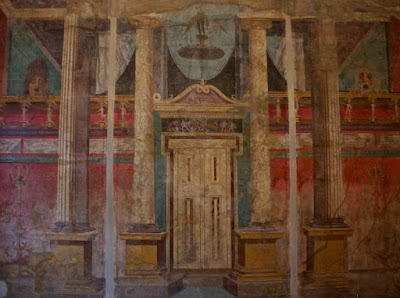Last week John and I went to the National Archeological Museum in Naples. We took an elevator to the top floor and spent the entire morning looking at frescoes from Pompeii and Herculaneum.
Pompeian interior designers favoured wall-to-wall patterns, often with three-dimensional effects -- to enlarge the rooms they decorated.
Mythological scenes and landscapes are painted onto the walls in the same way that we would hang paintings. I liked this Egyptian landscape topped with an ornate female mask.
Pompeian interior designers favoured wall-to-wall patterns, often with three-dimensional effects -- to enlarge the rooms they decorated.
Mythological scenes and landscapes are painted onto the walls in the same way that we would hang paintings. I liked this Egyptian landscape topped with an ornate female mask.
In this painting Io is welcomed by the Egyptian goddess Isis at Canapo.
This lovely fragment from the villa of Agrippa Postumus (AD 20) displays elements of perspective that would be lost until the Italian Renaissance.
The contours of the bodies in this image of Hercules and the centaur, Nessus, also from Agrippa Postumus, would similarly inspire Renaissance painters.
Let's enjoy some of the museums treasures. Cupid (Amor) is brought before Venus for impulsively firing his arrows at the wrong person (from Pompeii, House of Punished Love)
Cupid in the doorway draws Paris's attention to Helen, standing nearby. Their meeting will precipitate the Trojan War. Naughty Cupid! (House of Jason)
Pan playing his double flute accompanied by a nymph playing a lyre (House of Jason).
I was fascinated by these fragments of an image of unknown inspiration. But we moderns love our fragments.
Achilles forced to return a Trojan princess, Briseis, with whom he has fallen in love.
Venus and Mars with Cupid. The Romans were no strangers to romance.
This panel of pygmies on the Nile displays their pleasure in fantasy, exotica and humour.
We'll finish with John enjoying a with a wall of frescoes. Note the still lives of various food along the top. Also notice the central yellow rectangle with a small painting at the centre.
Here's a close look at that painting -- a nymph and satyr. With that, our time was up. We'll have to come back to the Archeology Museum soon.














Why don't we paint our walls with murals and frescos anymore?
ReplyDelete